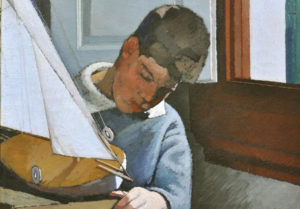A Visit to the Oscar Ghiglia Art Exhibition

Until September 13, 2022: OSCAR GHIGLIA. GLI ANNI DI NOVECENTO.Museo di Palazzo Medici Riccardi. Open daily 9 am – 7 pm, closed Wednesday. Admission to the exhibition and museum is €10, reduced price is €6. For more information, visit Palazzo Medici Riccardi website at http://www.palazzomediciriccardi.it/.
Curated by Leonardo Ghiglia, Lucia Mannini, and Stefano Zampieri, this show consists of still lives, portraits, and figure paintings by the talented artist Oscar Ghiglia, who lived between 1876 and 1945. Each piece vibrates with energy and character of its own because of the artist’s fresh way of painting in oil. His work has been widely admired ever since it reached the public’s eye.
Upon entering the exhibition on the ground floor of Palazzo Medici Riccardi, visitors will enjoy a room of powerful floral still lives intermixed with paintings of the figure – primarily of the artist himself and his wife. In Ghiglia’s still lives, the paintings’ textured surface qualities are so enticing that they almost make the viewer want to touch them. The petals of his flowers literally come up off the canvas, creating an impressive amount of depth. The paint is applied thickly and appears as if it were just painted due to its shine. Furthermore, each of his still lives throughout the exhibition incorporates a highly rendered and believable reflective object. These reflective objects not only add visual interest, but also take part in conveying Ghiglia’s interest in self reflection and portraying that through art.
Ghiglia was not known for being very outgoing and showy with his art, he was instead a reflective man who preferred to keep his work to himself. In addition to frequently using reflective objects as a painting subject, Ghiglia expressed this character trait in the way he depicted the female figures that accompany the aforementioned still lives. Each figure is turned away from the viewer, engaged in some everyday task that completely takes her attention away from being watched. Some examples include the Woman at the Mirror and the Green Reflection, two paintings of women with their backs towards the viewer staring in contemplation at a mirror and at green bottles respectively. In these pieces and the others like them, while emotion can be felt through the overall pose of the figure, the nuances of emotion that the subject feels remain hidden. This portrayal of women attentive to their tasks at hand rather than indulging in the spotlight on them parallels Ghiglia’s life as a highly esteemed artist who instead of basking in his fame, continued to work in a private way.

As a contrast to these mysterious figures whose exact emotional state remains unknown, there are also portraits in the exhibition that more directly confront viewers. The most striking of these paintings are the two self-portraits of Ghiglia in the act of painting. These works, unlike the other figural pieces, allow for a conversation between the viewer and subject because the subject appears
As a contrast to these mysterious figures whose exact emotional state remains unknown, there are also portraits in the exhibition that more directly confront viewers. The most striking of these are the two self-portraits of Ghiglia in the act of painting. These portraits, unlike the other figural pieces, allow for a conversation between the viewer and subject because the subject appears attentive. The look of Ghiglia’s focused eyes in these portraits makes the viewer feel as if they were the ones being painted, or perhaps that they had become the mirror at which Ghiglia was looking.
One of the most memorable of all of the pieces in the exhibition is a life-size painting of a female nude right next to the exit, painted with such attention to detail that it seems she must be alive. The painting is spectacular because when viewed from up close, the brushstrokes of different unexpected colors that follow the forms of each body part can be seen. Yet, when viewed from afar, the individual brushstrokes melt away and the only thing left is the vibrant figure that seems to pulsate. There are no hard edges that delineate forms, allowing for a grace and elegance that reveals how deeply Ghiglia was inspired by classical masters.
For anyone with an interest in an art exhibition that really leaves an imprint for its underlying themes and its aesthetic beauty, Oscar Ghiglia at Palazzo Medici Riccardi is a must-see. Each piece tells a story and feels animate, even when the subjects are objects rather than people. Through Ghiglia’s way of painting and way of experiencing the world, he manages to let us see the life and energy underlying all things. To see what this talented artist has preserved of his perceptions through painting is simply magical. (maddie aub)
